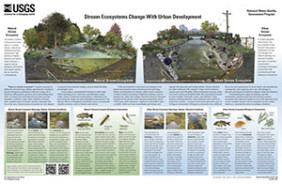
Product Details
- Product Number
- 523150
- Series
- CIR-1437
- Scale
- NO SCALE
- Alternate ID
- 21-1437
- ISBN
- 978-1-4113-4183-8
- Authors
- TERRY R MARET
- Version Date
- 01/01/2018
- Countries
- USA
- Media
- Paper
- Format
- Bound
Additional Details
- Description
-
Abstract
Sustaining the quality of the Nation’s water resources and the health of our diverse ecosystems depends on the availability of sound water-resources data and information to develop effective, science-based policies. Effective management of water resources also brings more certainty and efficiency to important economic sectors. Taken together, these actions lead to immediate and long-term economic, social, and environmental benefits that make a difference to the lives of the almost 400 million people projected to live in the United States by 2050.
In 1991, Congress established the U.S. Geological Survey (USGS) National Water-Quality Assessment (NAWQA) to address where, when, why, and how the Nation’s water quality has changed, or is likely to change in the future, in response to human activities and natural factors. Since then, NAWQA has been a leading source of scientific data and knowledge used by national, regional, State, and local agencies to develop science-based policies and management strategies to improve and protect water resources used for drinking water, recreation, irrigation, energy development, and ecosystem needs (https://water.usgs.gov/nawqa/applications/). Plans for the third decade of NAWQA (2013–23) address priority water-quality issues and science needs identified by NAWQA stakeholders, such as the Advisory Committee on Water Information and the National Research Council, and are designed to meet increasing challenges related to population growth, increasing needs for clean water, and changing land-use and weather patterns.
Excess nutrients are a pervasive problem of streams, lakes, and coastal waters. The current report, “The Quality of Our Nation’s Waters—Understanding the Effects of Nutrients on Stream Ecosystems in Agricultural Landscapes,” presents a summary of results from USGS investigations conducted from 2003 to 2011 on processes that influence nutrients and how nutrient enrichment can alter biological components of agricultural streams. This study included collecting data from 232 sites distributed among eight study areas. This report summarizes findings on processes that influence nutrients and how nutrient enrichment can alter biological communities in agricultural streams. These findings are relevant to local, State, regional, and national decision-makers involved in efforts to (1) better understand the influence of nutrients on agricultural streams, (2) develop nutrient criteria for streams and rivers, (3) reduce nutrients to streams and downstream receiving waters, and (4) develop tools for tracking nutrient and biological conditions following nutrient reduction strategies. All NAWQA reports are available online at https://water.usgs.gov/nawqa/bib/.
We hope this publication will provide you with insights and information to meet your water-resource needs and will foster increased citizen awareness and involvement in the protection and restoration of our Nation’s waters. The information in this report is intended primarily for those interested or involved in resource management and protection, conservation, regulation, and policymaking at the regional and national levels.
- Height In Inches
- 11.000
- Width In Inches
- 0.250
- Length In Inches
- 8.500
- Two Sided
- Yes
- Pieces
- 1
- Languages
- English



